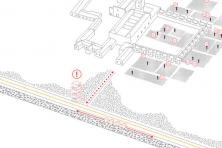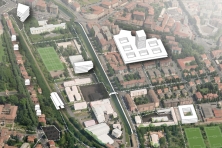Ride & Park
Workshop Pavia (IT) - "Adaptable Campus-City" - Workshop Site 2
PARTICIPANTS:
Egbert De Warle (NL), Marcus Kempers (NL), Winner in Assen (NL) with "Embrace the Present"
Elisabeth Sjødahl (SE), Runner-up in Bærum (NO) with "Elasti-City"
Enrico Busato (IT), Sara Pezzutti (IT), Runner-up in Ciney (BE) with "Chute"
Antoine Carel (FR), Mickael Papin (FR), Runner-up in Haninge (SE) with "Traffic Island"
Anssi Lauttia (FI), Kuutti Halinen (FI), Tuomas Raikamo (FI), Winner in Kuopio (FI) with "Savo Nueva"
Alessandro delli Ponti (IT), Ilaria Novielli (IT), Winner in Mannheim (DE) with "Mannheim's Connection"
Coach: Benrd Vlay (AT)
Assistants: Matteo Locatelli (IT)
SITE 2 - THE NAVIGLIO: A CHANCE OF COEXISTENCE BETWEEN STUDENTS AND CITIZENS
Large-scale infrastructures are not only the primary condition to network a territory through a system of links. More and more infrastructures have converted to important spatial spheres for different kind of activities and programs. Being part of the historical Lombardian system of naviglios (i.e. canals), the Naviglio Pavese represents an outstanding infrastructural project that provides the perfect example for testing modes of adaptability through which this infrastructure can become a space that fundamentally transforms the meaning and performance of a city, or even a region. The territorial scale of the Naviglio Pavese clearly provokes the tension between regional logics and local impacts. This unavoidable ambiguity becomes productive if we consider the context of recent urban transformations in times of shrinking resources. The disappearance of large-scale production complexes in city areas, the growing importance of sustainable and more efficient mobility-systems, new models of civic initiatives and the increasingly dominant role of nature and public landscape as identifying elements give waterline infrastructures such as the Naviglio the potential to fundamentally change urban conditions, which is a central concern among young architects.
The results of the Pavia workshop addresses this concern in very specific ways: “Gran Pavia – the Territorial Campus” focuses on the added value through local and regional cross-programming; “Ride & Park” reveals the extraordinary potentials of change that can be triggered by a more sustainable concept of mobility; “The Sleeping Beauty” suggests a new geography of sharing across the boundary of the Naviglio through a radical intervention in the university heritage of the city.
Ride & Park
Download the PDF here
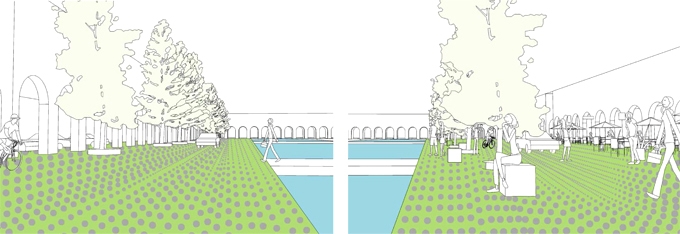
The project interprets the canal as a public urban landscape whose character is driven by a slow-motion program of mobility. Following the insight that the reduction of speed along the canal affects the overall efficiency of mobility in a positive way, the project suggests a series of “slowing-down interventions” in order to convert the linear infrastructure to a “mobility landscape”. Some interventions are so light that it would be easy to start “tomorrow” with the conversion of the canal. On the one hand the slowing-down operation will convert the separating infrastructure to an attractive magnet through its new public programs, offering markets, events, culture, leisure and sports activities. On the other hand the attractive spine offers a unique opportunity to reactivate the hidden, abandoned spaces along the canal, giving them an attractive frontline. Above all, the role of time is the project key feature: through “rhythmic design” the Naviglio can be radically converted without heavy interventions, exploiting the different conditions of speed and intensity according to the rhythms of days, weeks and seasons.
Download the PDF here
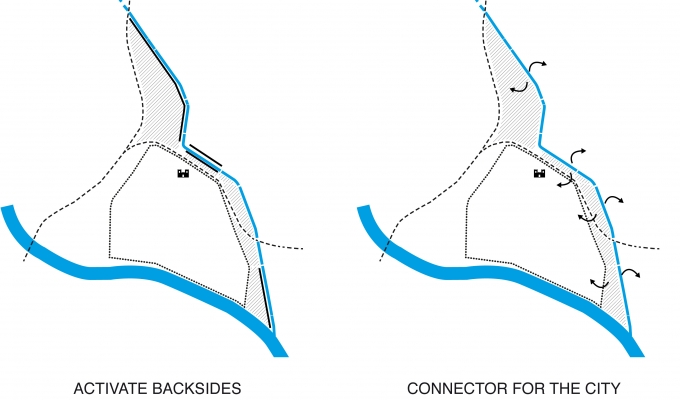
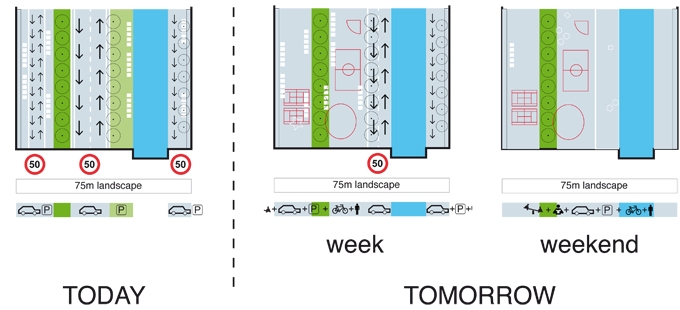
See other projects on the same site:
See the other sites:
- Creating an Inter-Campus Dynamic Axis
- Sharing the Ticino River: Sports and Leisure
